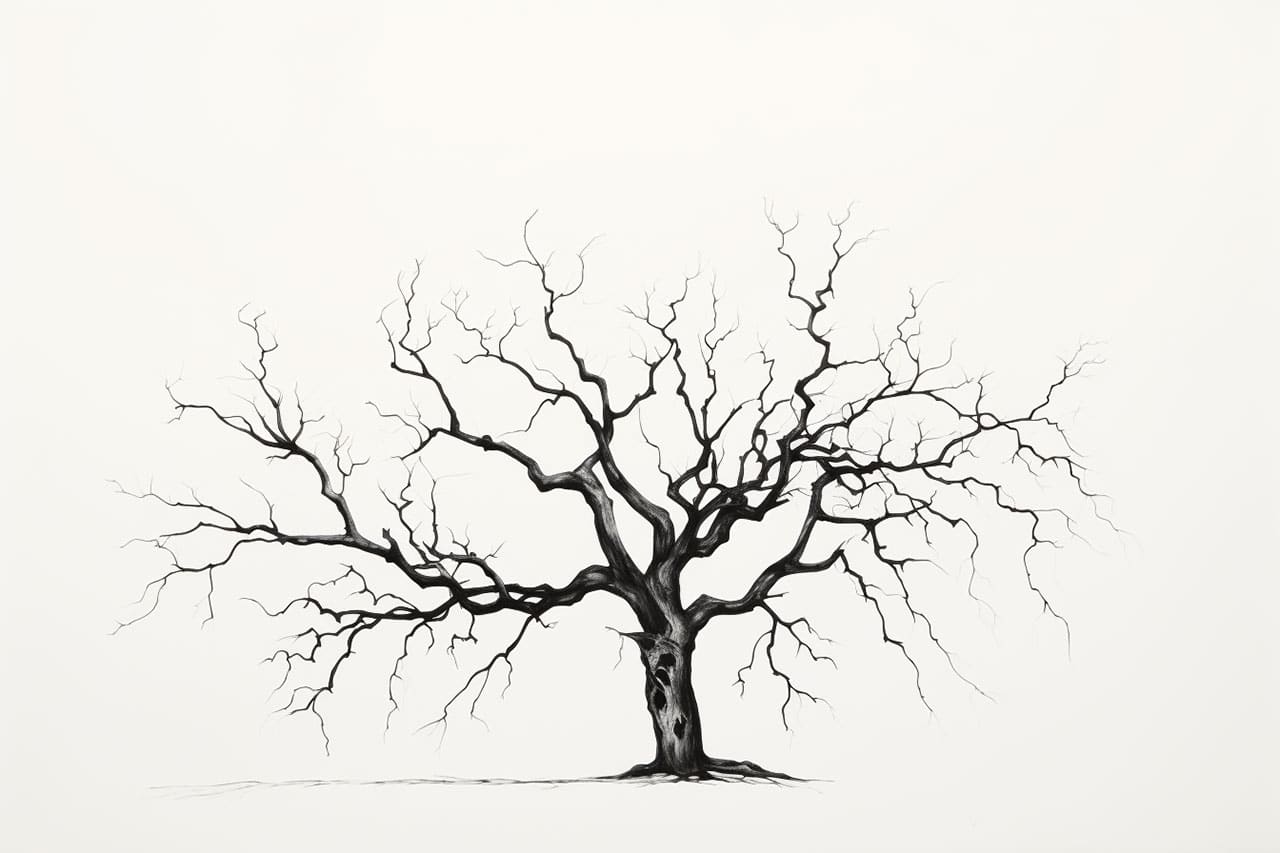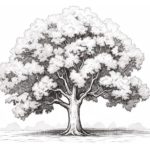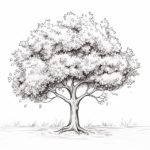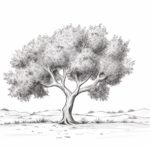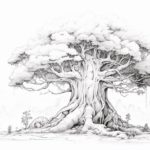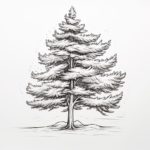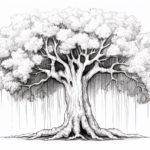
Drawing a dead tree can be an incredibly rewarding experience for artists, regardless of their skill level. Unlike their vibrant, living counterparts, dead trees possess a haunting beauty that captivates the imagination. The unique shapes, gnarled branches, and intricate details found in withered trees can add a profound sense of depth and character to your artwork, making them an intriguing subject to explore.
Creating a realistic dead tree requires attention to detail and a willingness to embrace imperfection. The process is slightly more challenging than drawing a live tree, as it involves capturing the starkness and complexity of the tree’s structure. Whether you’re just starting your artistic journey or are an experienced artist seeking to refine your skills, this guide will provide you with a clear, step-by-step approach to help you master the art of drawing a dead tree.
As we embark on this artistic endeavor, you will learn not only the technical aspects of creating a lifelike depiction but also how to appreciate the character that a dead tree embodies. From selecting the right materials to executing intricate details, this guide aims to enrich your understanding of tree anatomy while encouraging you to express your unique artistic voice. So, let’s gather our tools and dive into the fascinating world of drawing dead trees!
Materials Required:
Before we dive into the steps, let’s assemble the materials you’ll need:
- Drawing paper or sketchpad
- Pencil set (HB, 2B, 4B, 6B)
- Eraser
- Blending stump or cotton swabs
- Charcoal pencils (optional)
- Charcoal sticks (optional)
Now that we have our materials ready, let’s get started on creating a stunning representation of a dead tree.
Step 1: Outline the Basic Shape
Begin by lightly sketching the basic shape of the tree trunk and branches using an HB pencil. Pay attention to the overall structure and proportions. Remember, dead trees often have irregular shapes, so embrace asymmetry and imperfections. Focus on capturing the essence rather than striving for perfection.
Step 2: Add Texture and Details
Using a softer pencil such as 2B, start adding texture and details to the tree trunk. Dead trees often have rough, cracked bark, so create lines and broken edges to depict these characteristics. Vary the pressure on your pencil to achieve a range of values, emphasizing shadows and highlights to amplify the withered appearance.
Step 3: Branch Out
Now, let’s move on to the branches. Begin by adding the main branches, ensuring they flow naturally from the trunk. Dead branches tend to be twisted and gnarled, so experiment with different angles and curves to create an organic look. Gradually add smaller branches and twigs, branching out from the main structure.
Step 4: Enhance the Details
To further enhance the realistic look of the dead tree, use a 4B or 6B pencil to add more texture and details to the trunk and branches. Introduce darker shades and create deeper cracks and crevices. Pay close attention to the areas where branches intersect, as these intersections often create interesting shapes and shadows.
Step 5: Emphasize Shadows and Highlights
Shadows and highlights are essential in giving depth and dimension to your drawing. Identify the primary light source and imagine how it would cast shadows on the tree. Use your pencil to darken areas that would be in shadow, and leave lighter areas to represent highlights. Gradually build up layers to achieve the desired contrast and tonal range.
Step 6: Blending and Smudging
To create a smoother and more realistic texture, blend and smudge certain areas of your drawing using a blending stump or cotton swabs. This technique helps soften harsh lines and merges different values together. Be careful not to over-blend, as some roughness and texture should remain to portray the rugged nature of the dead tree.
Step 7: Optional: Charcoal for Added Depth
For those who want to take their drawing to the next level, you can introduce charcoal pencils or sticks to enhance the depth and darkness of your dead tree. Use these tools to add deeper shadows and create a richer contrast. Experiment with different charcoal grades to achieve the desired effect while maintaining control over the details.
Conclusion
Drawing a dead tree offers a unique opportunity to explore shape, texture, and contrast. By following these step-by-step instructions, you can create a realistic representation of a withered tree that captures its character and beauty. Remember to embrace imperfections, experiment with different techniques, and most importantly, have fun with your art.
So, grab your pencils and paper, and start bringing a lifeless tree to life on your canvas. With dedication and practice, you’ll soon master the art of drawing a dead tree!
Next, you can experiment with different types of trees like the Willow tree, or various tree “parts” such as the pinecone.
Fun Facts About Dead Trees
- Dead trees, often referred to as snags, provide crucial habitats for many wildlife species, including birds, insects, and small mammals.
- Even in their lifeless state, dead trees contribute to the ecosystem by serving as carbon storage, releasing nutrients back into the soil as they decompose.
- In art and literature, dead trees are frequently used as symbols of resilience, history, and the passage of time.
- Many fungi species, including mushrooms, grow on dead trees, playing an essential role in decomposition and nutrient cycling.
- Woodpeckers, known for their drumming, often use dead trees to excavate nesting cavities and search for insects.
- Dead trees can sometimes remain standing for years, slowly decaying while still providing structural support for other plants and vines.
- The texture and patterns found on the bark and wood of dead trees can serve as inspiration for artists and photographers.
- Forestry management often involves leaving some dead trees in place to maintain ecological balance and support biodiversity.
- In some cultures, dead trees are revered as sacred, believed to embody the spirits of ancestors or nature deities.
- Lightning strikes are a common cause of tree death, creating dramatic, natural sculptures in the landscape as they char and splinter.
Suggestions for Scenes and Settings for Dead Tree Drawings
- Desert Oasis: Portray a lone dead tree standing against the backdrop of dunes and a vast, starry sky reflecting solitude and resilience.
- Haunted Forest: Create a chilling scene where twisted, leafless trees seem to whisper secrets under a moonlit sky, shrouded in mist.
- Winter Wonderland: Illustrate a snow-covered landscape where dead trees form striking silhouettes against a pale, wintry daylight.
- Wildlife Haven: Capture a vibrant ecosystem where a dead tree serves as a bustling home to birds, insects, and other creatures.
- Abstract Pattern: Focus on the intricate, gnarled textures of deadwood, showing close-ups of bark patterns and knots.
- Cemetery Guardians: Sketch abandoned graveyard scenes where ancient dead trees stand sentinel over weathered tombstones.
- Mystical Portal: Depict a hollow, dead tree trunk as an enchanted gateway to another world, glowing with ethereal light.
- Urban Decay: Illustrate dead trees standing among the ruins of an old city, symbolizing nature’s endurance amidst human decline.
- Landscape Contrast: Paint a vibrant landscape with fields and mountains in the background, contrasted by a central, stark dead tree.
- Time’s Passage: Show a series of connected dead trees in different stages of decay, representing the cycle of life, death, and renewal.

